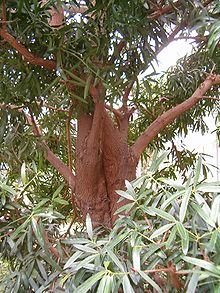Mau forest
The Mau Forest is a mountain forest in the Rift Valley in Kenya and the largest indigenous forest in East Africa . It extends over an area of 273,300 hectares and an altitude between 1,800 and 3,000 meters above sea level. Twelve of the Kenyan rivers have their source in the Mau Forest, including the southern Uaso Nyiro , the Sondu River , the Mara River, and the Njoro River . These rivers feed Lake Victoria , Lake Nakuru, and Lake Natron in Tanzania . The Mau Forest was the original home of the Okiek and is used by the Maasai nomads as grazing land for cattle during the dry season.
Flora and fauna
Pouteria adolfi-friedericii , Strombosia scheffleri and Polyscias kikuyuensis mainly grow in the Mau forest . Furthermore, there are Olea capensis , Prunus africana , Albizia gummifera and Podocarpus latifolius . The Mau forest is habitat for many species of birds including the Hartlaub's Turaco , Mountain Buzzard , Nyanza Swift , Kehl binding woodpecker and the Oriole Finch . The forest area also includes bongos , yellow-winged duikers , African golden cats , giant forest pigs , leopards , hyenas , buffalo , black and white colobus monkeys and impalas .
Destruction of the ecological balance
The continued deforestation of the Mau forest, which has already lost a third of its original tree population, is leading to ever longer periods of drought in Kenya. The cool air that rises from the Mau forest collides with the warm air masses that come from Lake Victoria . This creates regular rains. The radical deforestation leads to fewer trees, less cool air and therefore less rain overall. With deforestation, the Mau forest also loses the ability to store water in the rainy season and to release it evenly in the dry season to the rivers whose headwaters it represents. As a result, the source rivers of the Mara carry less water in the dry season, but the region is threatened with flooding in the rainy season. In addition, the rain washes earth from cleared areas into the rivers, which silts up while the eroded soil loses fertility.
In 2009, the people who had settled on the deforested areas had to leave the area on the instructions of the Kenyan government under Mwai Kibaki . The government wants to compensate those settlers financially who own less than five hectares of land and who can prove that their land ownership is not based on a gift from former President Daniel arap Moi .
Web links
- Drought in Kenya's bathroom . In: taz , July 9, 2009
Individual evidence
- ↑ a b c BirdLife IBA factsheet
- ↑ Kenya: The Mau Forest Complex threatened . ( Memento of the original from November 21, 2010 in the Internet Archive ) Info: The archive link was inserted automatically and has not yet been checked. Please check the original and archive link according to the instructions and then remove this notice. World Rainforest Movement, accessed April 5, 2010.
- ^ Forest Mau: Problems with deforestation and forest degradation . ( Page no longer available , search in web archives ) Info: The link was automatically marked as defective. Please check the link according to the instructions and then remove this notice. ( Microsoft PowerPoint ) Retrieved April 5, 2010.
- ↑ Antje Diekhans: When the rain stops ( memento from September 22, 2009 in the Internet Archive ), article from September 22, 2009 on tagesschau.de , accessed on April 5, 2010.
- ↑ Kirsten Milhahn: A river is fighting for its life. In: Die Zeit , No. 50/2014, December 19, 2014, accessed on April 9, 2016.
- ↑ United Nations Environment Program (Ed.): Deforestation Costing Kenyan Economy Millions of Dollars Each Year and Increasing Water Shortage Risk. In: UNEP News Center , November 5, 2012, accessed April 9, 2016.
- ↑ Ilona Eveleens: Kenya's green lungs take a deep breath , article in the taz of November 14, 2009, accessed on April 5, 2010.


